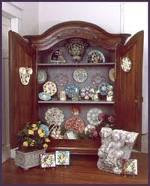In today's modern world, has called for just about anything old and antique in terms of quality and this is true. In fact, artifacts and products that are more than 100 years old or products that are rare enough to have some value. In other words, antiques and old items in limited supply. And more limited, and more obsolete in this item.
Another way to think of something as collectible antiques. If this item is a piece of furniture you want to collect to improve the appearance of the room, and a piece of ceramics to decorate the corner cupboard, or some silverware you want to download to your grandchildren, you should be elements of a rare enough to be considered antiques. Another thing to goods used or unwanted.
People misunderstanding one about antiques is that they look older and more antique they must be. True! Appearance has nothing to do with it. Just because the piece seems to be out of the attic grandma does not mean it's obsolete, although the novelty might be. Not in the true sense of the word. If no one wants it, no matter how old seems, it's just a piece of junk. Antiques have value, and value on the basis that demand due to suitability and limited supply.
Most people become interested in antiques to one of two reasons: either to have an interest in the collection of a certain kind of purely personal antique ceramics or pottery enjoyment are the most common, or they inherit some of the elements of family members. But everyone wants to be sure of one thing, that what they buy or inherit will appreciate in value. This is what antiques are all about, right? All these stories about some people who buy a piece of junk in the garage sale that turns out to be of archaeological value worth thousands of dollars are in fact true, is not it? If they can do it, why can not?
But before you get your hopes up, you need to know something about what you have. Principles apply when collecting antiques: We know everything you can about the antiques that interests you and get the lowest possible price. So you will not only get the maximum enjoyment from owning antique, but you'll also be sure that your investment appreciates in value.
Many people, however, inherits the item or a whole house full of antiques from a relative. Only the largest possible number of those who do not have an interest in antiques so great aunt left them with a group of them. Then dollar signs begin to emerge. What most do not consider is that much of what Great Aunt was probably just junk, but if she was a seasoned collector and knew what he had. True, people have bought the furniture to decorate their homes a long time since the furniture, and that if it was good quality when new, is now what it's worth.
But could only professional appraiser tell you that. And assessment costs money something like $ 100-150 an hour. Before you ask how much a person an item worth, and be prepared to shell out a few dollars to get the information. And guess why charge so much to do most of its insurance companies, lawyers, real estate settlement. Evaluation is not an exact science, but it requires an appraiser to do a lot of research and then prepare a detailed report that accepted in a court of law.
How do you do to know whether an item is an antique? By learning as much as possible about the artifacts you want to collect and or inherited. Libraries and libraries do not help much. Row on row of antique books covering every conceivable in the greatest detail. Books on pottery, glassware, dolls and even the old movie memorabilia fill the shelves as far as the eye can see. Not to mention the evidence of price: there are enough of them to sink the ship. Just get a simple understanding of the antique collection of the year you are going to have to spend a fortune on your favorite library or spend every free evening browsing the library shelves of your favorite.













No comments:
Post a Comment